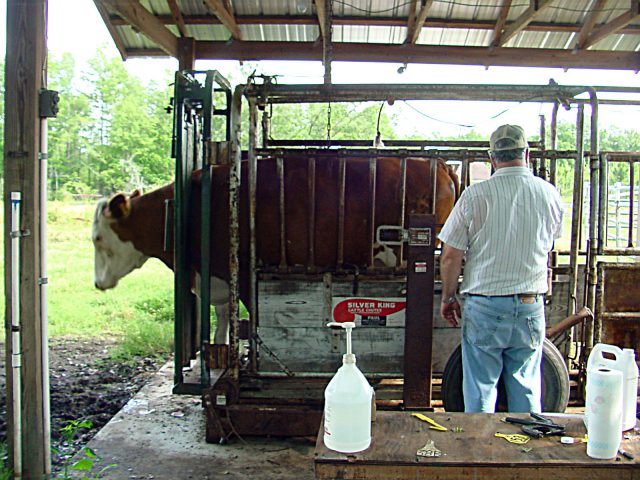
It is the cattle owner’s responsibility to ensure that the withdrawal time indicated on the label of certain medications must pass between the last treatment and the time the animal will be slaughtered for human consumption. Photo credit: Doug Mayo, UF/IFAS
Glenn Selk, Oklahoma State University Emeritus Extension Animal Scientist
Summer time often brings a few infectious ailments to beef cows. Common problems include eye infections and foot rot. Treatment of affected cows will often involve the use of antibiotics.
In the past, and on very rare occasions, violative residues of pharmaceutical products have been found in carcass tissues of cull beef cows. Violations of drug residue regulations can result in expensive fines (or even worse, jail time) for the rancher and a “black-eye” for the entire beef industry. It is vital that cow calf producers have a close working relationship with a large animal veterinarian in their area. If a cow has an infection or disease that must be treated, her owner should closely follow the veterinarian’s directions, and also read the label of the product used. Most of these medications will require that the producer keep the treated animal for the label-directed withdrawal time. The Oklahoma Beef Quality Assurance Manual contains the following discussion of medication withdrawal times.
“A withdrawal time may be indicated on the label of certain medications. This is the period of time that must pass between the last treatment and the time the animal will be slaughtered or milk used for human consumption. For example, if a medication with a 14-day withdrawal period was last given on August 1, the withdrawal would be completed on August 15 and that would be the earliest the animal could be harvested for human consumption. All federally approved drugs will include the required withdrawal time for that drug on the product label or package insert. These withdrawal times can range from zero to as many as 60 days or more. It is the producer’s responsibility to be aware of withdrawal times of any drugs used in their operation. Unacceptable levels of drug residues detected in edible tissues collected at harvest may result in traceback, quarantine, and potential fines or jail time. Substantial economic losses may result for the individual producer as well as negative publicity for the entire beef industry…”
Producers are responsible for residue problems and should follow these four rules:
-
If ever in doubt, rely on the veterinarian-client-patient relationship you have established with your veterinarian.
-
Use only medications approved for cattle and exactly as the label directs or as prescribed by your veterinarian.
-
Do not market animals for food until the withdrawal time listed on the label or as prescribed by the veterinarian has elapsed.
-
Keep well organized, detailed records of pharmaceutical products given to individually identified animals. Include in the record, the date of administration, route of administration, dosage given, lot or serial number of product given, person delivering the product, and label or prescription listing of withdrawal dates. Examples of Beef Quality Assurance records can be found in the Oklahoma Beef Quality Assurance Manual website at the menu item “Record Keeping Forms” . Records should be kept for 3 years after sale of the animal.
- Federal Estate Tax and Gift Tax Limits Announced For 2026 - December 19, 2025
- Why Do I Have So Many Open Cows? Causes of Reproductive Failure - December 19, 2025
- Wiregrass Cotton Expo Offers Resources, Research, & Real Solutions for Growers in Southeast – January 22 - December 19, 2025
